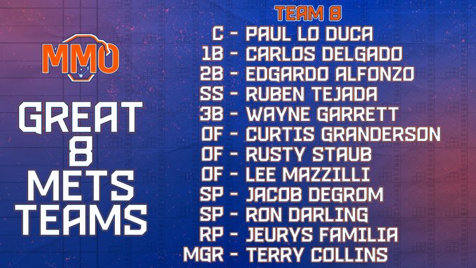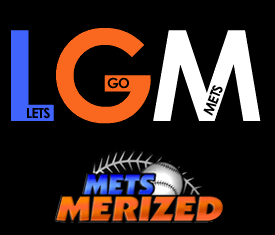
People have been asking us all winter what we’ve been doing to pass the time during the MLB lockout. I’ll tell you what we do here at MMO — we come up with ideas that not only help us stay busy, but will help you all stay busy, too.
Talking about the best teams and/or players in New York Mets history is always a good debate to have — especially during the cold winter months — but what if we created our own teams with players from different eras? That’d be fun, right? Well, we thought it was, and we think you’ll agree. We’ve created eight different Mets teams, all of which consist of a catcher, first baseman, second baseman, shortstop, third baseman, three outfielders, two starting pitchers, one relief pitcher, and a manager. We took the top eight at each position (as well as the top 24 for outfielders and top 16 for starting pitchers) with the goal of splitting them up across eight teams and making them as evenly matched as possible.
We used four players twice, given their multi-positionality: Edgardo Alfonzo (2B/3B), Jeff McNeil (2B/OF), John Milner (1B/OF) and Dave Magadan (1B/3B).
What we’ve done over the past eight days is introduce each of the squads while taking a look at their perceived strengths and weaknesses. This article will complete that exercise, meaning the fun will start with some good ol’ fashioned Twitter polls so you can decide which ones would be victorious if they faced one another starting February 8th.
The Squad: Team 8

Strengths
It’d be just flat-out wrong to start with any other strength of this club than the pitching staff, and more specifically, the one-two rotation punch of Jacob deGrom and Ron Darling. You’ve all seen the seven other squads that’ll be in this competition (if you haven’t yet, scroll to the bottom for links to each)…is there a better duo than these two? I’m not so sure. They’re both among the franchise’s top-10 in fWAR (38.9 for deGrom, 15.8 for Darling), and among the top-20 in ERA (2.50 for deGrom, 3.49 for Darling).
What I love the most about this duo, though, is their collective durability. Darling never hit the injured list during his time with the Mets, and although deGrom missed half of 2021, he’s typically been the one constant in New York’s rotation since his debut (he has four years of 190-plus innings to prove it, too).
Between Curtis Granderson, Rusty Staub, and Lee Mazzilli, this squad’s outfield shares one important characteristic: an ability to reach base at a high clip. In their respective Mets careers, none had an on-base percentage below .340. Add in Paul Lo Duca‘s ability to get on base, and that’s a lot of ducks on the pond for dudes like Edgardo Alfonzo and Carlos Delgado to do some work.
Weaknesses
When looking at this club’s defensive alignment, there’s a lot to like, but in comparison to the rest of the squad, the left side of the infield is probably not up to snuff. I love me some Ruben Tejada, but he could never quite put a full season together for the Mets. Wayne Garrett actually put three seasons of 2.0-plus fWAR together and brings the experience that is two World Series appearances to the table, which is a good thing.
But, again, when comparing these two to the rest of the club — and the other shortstop-third base duos that’ll be in this competition — it’s just not the same.
When it comes to the most effective relievers in Mets history, Jeurys Familia is actually high on a few lists. His 124 career saves are third all-time, while his 5.4 fWAR is fifth-best and his 3.30 ERA is in the top-30. That’s all great, but as we’ve seen over the years, Familia has a propensity of getting himself into jams before escaping, which isn’t always a successful strategy as a relief pitcher. After peeking again at the other relievers in this competition, there are probably two or three that are a little more dependable.
Other Teams















